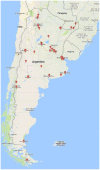The Role of Prescribing Generic (Non-proprietary) Drugs in the Prevalence of Therapeutic Inertia in Multiple Sclerosis Care
- PMID: 30369904
- PMCID: PMC6194175
- DOI: 10.3389/fneur.2018.00835
The Role of Prescribing Generic (Non-proprietary) Drugs in the Prevalence of Therapeutic Inertia in Multiple Sclerosis Care
Abstract
Importance: The prescription of generic (non-proprietary) compared to brand-name drugs is increasing worldwide. In many developing and emerging countries, generics companies market products at similar costs as brand-name competitors benefiting from more flexible compliance rules and regulations for marketing their products in the health system. Together, this phenomenon may influence prescriber's behavior (e.g., maintaining the same treatment despite guideline's recommendations or despite evidence of disease progression). Objectives: To compare the prevalence of therapeutic inertia (TI) between primary prescription of brand-name vs. generic drugs in the management of MS in Argentina. Design: We conducted a population-based online study comprising 117 neurologists with expertise in MS. Participants answered questions regarding their clinical practice, most commonly prescribed disease modifying agents, and therapeutic choices of 10 simulated case-scenarios that assessed TI. Inertia was defined as the lack of treatment initiation or escalation despite evidence of clinical and radiological activity (8 case-scenarios, 720 individual responses). We created the generic-brand name score (GBS) according to the 5 most frequently prescribed generic (n = 16) vs. brand-name (n = 9) drugs for MS, where scores higher than 1 indicated higher prescription of generic drugs and scores lower than 1 indicated higher prescription of brand-name agents. Candidate predictors of prescribing generic drugs included demographic data, MS specialist vs. general neurologist, practice setting, years of practice, volume of MS patients, risk preferences, costs of annual treatment. Participants and setting: population-based prospective study using including neurologists who care for patients with multiple sclerosis across Argentina. Exposure: prescription of generic vs. brand-name MS drugs Main outcome of interest: Therapeutic inertia (TI), defined as lack of treatment escalation when goals are unmet. Secondary outcomes included factors associated with generic drug prescription and costs of MS treatment. Results: Ninety participants completed the study (completion rate 76.9%). TI was observed in 153 (21.3%) of participants' responses. The evaluation of aggregate responses revealed a mean GBS score (SD) of 3.44 (2.1), with 46 (51.1%) participants having a GBS equal to or higher than 1. Older age (OR 1.19; 95% CI 1.00-1.42), being a general neurologist (OR 3.91; 95% CI 1.19-12.8), and being more willing to take risks in multiple domains (SOEP score OR 1.06, 95% CI 1.01-1.12) were associated with higher prescription of generic drugs in MS care. Costs of treatment were not associated with prescribing generic drugs. There was no difference in the annual costs of MS treatment for primary prescribers of brand-name vs. generic drugs (67,500 US$ vs. 67,496 US$; p = 0.99). The evaluation of individual responses revealed that participants with higher prescription of generics-reflected by a higher GBS-had higher incident risk of TI (mean GBS 3.61 for TI vs. 2.96 for no TI; p < 0.001). Multivariate analysis revealed that a prescription of generic agents was associated with an increased incident risk of TI (OR 1.56; 95%CI 1.07-2.29). There was no difference in the annual costs of MS treatment for participants that exhibited TI vs. those without TI (67,426 US$ vs. 67,704 US$; p = 0.66). Conclusions: General neurologist, older age, and willingness to take risks were associated with increased prescription of generic drugs despite similar costs compared to brand-name agents. In our study, the prescription of generic-MS drugs was associated with a higher incident risk of therapeutic inertia.
Keywords: decision making; disease-modifying therapy; generic drugs; inertia; multiple sclerosis; outcomes; risk aversion.
Figures
Similar articles
-
Comparison of Physician Therapeutic Inertia for Management of Patients With Multiple Sclerosis in Canada, Argentina, Chile, and Spain.JAMA Netw Open. 2019 Jul 3;2(7):e197093. doi: 10.1001/jamanetworkopen.2019.7093. JAMA Netw Open. 2019. PMID: 31314113 Free PMC article.
-
Therapeutic Inertia in Multiple Sclerosis Care: A Study of Canadian Neurologists.Front Neurol. 2018 Sep 24;9:781. doi: 10.3389/fneur.2018.00781. eCollection 2018. Front Neurol. 2018. PMID: 30319523 Free PMC article.
-
Emotional expressions associated with therapeutic inertia in multiple sclerosis care.Mult Scler Relat Disord. 2019 Sep;34:17-28. doi: 10.1016/j.msard.2019.05.029. Epub 2019 Jun 4. Mult Scler Relat Disord. 2019. PMID: 31226545
-
Can Generic Medications Be a Safe and Effective Alternative to Brand-Name Drugs for Cardiovascular Disease Treatment? A Systematic Review and Meta-Analysis.Rev Cardiovasc Med. 2025 Mar 7;26(3):26116. doi: 10.31083/RCM26116. eCollection 2025 Mar. Rev Cardiovasc Med. 2025. PMID: 40160563 Free PMC article.
-
Physicians are more likely than non-physicians to use brand-name drugs to treat their chronic conditions.J Epidemiol Community Health. 2017 Sep;71(9):874-881. doi: 10.1136/jech-2016-208837. Epub 2017 Jul 3. J Epidemiol Community Health. 2017. PMID: 28674077 Review.
Cited by
-
Comparison of Physician Therapeutic Inertia for Management of Patients With Multiple Sclerosis in Canada, Argentina, Chile, and Spain.JAMA Netw Open. 2019 Jul 3;2(7):e197093. doi: 10.1001/jamanetworkopen.2019.7093. JAMA Netw Open. 2019. PMID: 31314113 Free PMC article.
-
Nocebo in Biosimilars and Generics in Neurology: A Systematic Review.Front Pharmacol. 2019 Jul 24;10:809. doi: 10.3389/fphar.2019.00809. eCollection 2019. Front Pharmacol. 2019. PMID: 31396084 Free PMC article.
-
Factors Influencing Drug Prescribing for Patients With Hospitalization History in Circulatory Disease-Patient Severity, Composite Adherence, and Physician-Patient Relationship: Retrospective Cohort Study.JMIR Aging. 2024 Dec 6;7:e59234. doi: 10.2196/59234. JMIR Aging. 2024. PMID: 39421979 Free PMC article.
References
-
- Rae-Grant A, Day GS, Marrie RA, Rabinstein A, Cree BAC, Gronseth GS, et al. . Practice guideline recommendations summary: disease-modifying therapies for adults with multiple sclerosis: Report of the Guideline Development, Dissemination, and Implementation Subcommittee of the American Academy of Neurology. Neurology (2018) 90:777–88. 10.1212/WNL.0000000000005347 - DOI - PubMed
-
- (FDA) FaDA Generic Drugs (2018). Available online at: https://www.fda.gov/Drugs/ResourcesForYou/Consumers/QuestionsAnswers/ucm....
LinkOut - more resources
Full Text Sources



